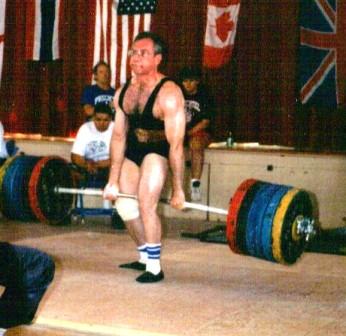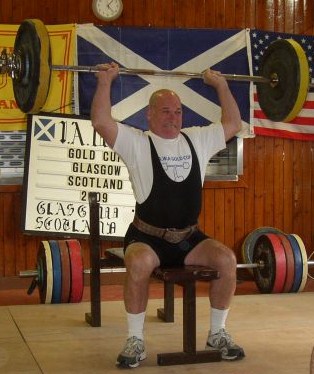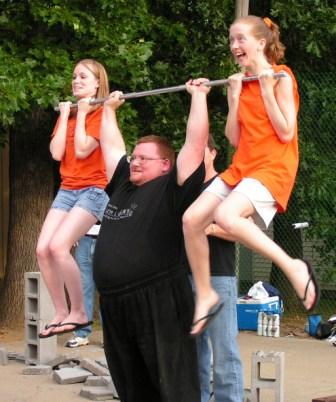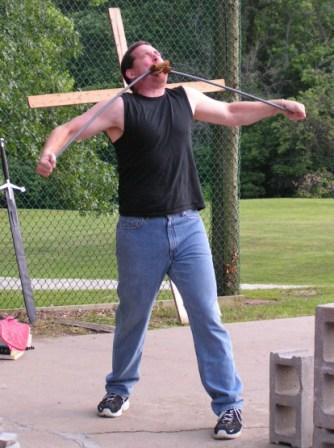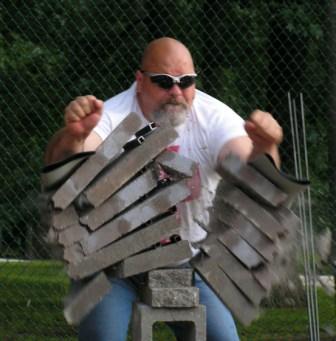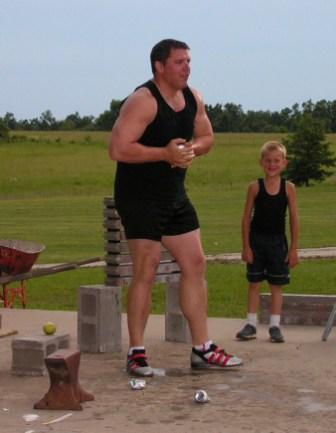The 2009 IAWA Gold Cup – A Great Success!
by Steve Gardner
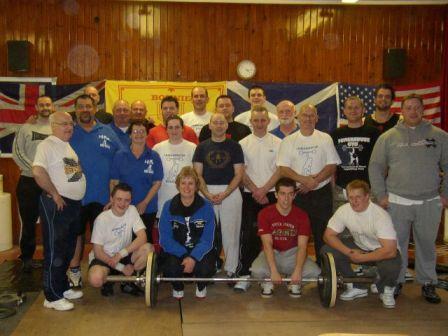
2009 IAWA Gold Cup Group Picture
There were 25 lifters taking part in this years Gold Cup World Record Breakers Tournament, which was held in Glasgow, Scotland. All of the hard work and effort put in by this years promoter David McFadzean and his support team at the Castlemilk Gym Club, was repaid in fine style as the 2009 event was a great success. The list of impressive records that were broken and set was of a very high standard, with several new lifters taking part and giving a good account of themselves too! A big welcome into the IAWA family goes out to: The Hughes trio, sister and brothers, Nicola, Robbie and Chris, and also to Alan Higgs and Tom Moffat, they all lifted well. It was nice to see Frank Allen back in action, and also Steve Angell on impressive form. People were pleased to see Karen Gardner perform her first lifting since her Cancer operation a year ago, and Agnes Mcinally who is slowly returning to form after her problems too, Agnes says she has found a new incentive in the sport: helping to coach new lifter Nicola Hughes. Denny Habecker from the USA never fails to delight us on the platform, and he too is recently back from a hip operation. Mark Haydock lifted the heaviest ever trap bar deadlift at 323.5 kilos much to the delight of a heavily pregnant Mrs Haydock (soon to deliver). All in all it was a really nice day, a good competition in a great atmosphere. Well done again to David and his team on a job well done!
FULL MEET RESULTS:
IAWA Gold Cup 2009
Castlemilk, Glasgow, Scotland. Saturday 7th November
Promoter: David McFadzean (assisted by members of the Castlemilk Gym)
Lifter Class Div Lifts
Steve Gardner 125+ M50+ R/H Ring Finger Lift 80k – L/H Index Finger Lift 75k
Frank Allen 90 M65+ Pullover at arms Length 45k
David McFadzean 100 Open R/H Dumbell Deadlift 105k
Bill Wright 80 65+ R/H Dumbell C+Jerk 35k
Karen Gardner 80 50+ R/H Mid Finger Lift 40k – R/H Index Finger Lift 40k
Nicola Hughes 90 Open 2 inch bar Straddle D Lift 107.5k – L/H Zercher 60k
Chris Hughes 70 J18/19 2 inch bar Straddle D Lift 155k
James Gardner 95 Open R/H Dumbell Deadlift 147k
Robbie Hughes 60 J14/15 Trap Bar Deadlift 135k
Agnes Mcinally 65 M50+ 2 inch bar Straddle Deadlift 90k
George Dick 125+ M60+ Steinborn Lift 115k – Front Squat 110k
Graham Saxton 110 M45+ Steinborn Lift 137.5 – 2 inch bar Hacklift 202.5k
Chris Ross 95 Open L/H Middle finger Lift 102.7k
Mathew Finkle 70 M40+ 2 inch bar Hacklift 120k
Alex Rigbye 95 Open 2 Hands Thumbless Deadlift 142.5
Tom Moffat 95 Open Trap Bar Deadlift 260k – 2 inch bar Straddle D Lift 230k
Steve Angell 110 Open Trap bar Deadlift 300k
Joshua Haydock 70 J18/19 Trap Bar Deadlift 182.5k – Front Squat 105k
Mark Haydock 125 Open 2 Hands Thumbless D Lift 200k – Trap Bar D Lift 323.5k
Denny Habecker 90 M65+ Seated C+ Press B/Neck 60k – Trap Bar D Lift 160k
Alan Higgs 95 M50+ Trap Bar Deadlift 190k
Andy Tomlin 95 M40+ Middle Fingers Deadlift 140k
Steve Andrews 70 M50+ R/H Zercher 100k – L/H Thumbless D Lift 66k
Karl Birkinshaw 85 Open Reflex C + Push Press 62.5k – Bwt Reps DLift 83k x 41 reps
Graham Always 110 Open L/H Bench Press 32.5k
2 Man Lifts:
David McFadzean and Chris Hughes (Open 100k Class) 2 Man Hacklift 280k
Mathew Finkle and Robbie Hughes (Open 70k Class) 2 Man Straddle Dead Lift 250k
Andy Tomlin and Chris Ross (Open 95k Class) 2 Man Straddle Dead Lift 350k
MC Recorder: Steve Gardner Assistant: Judy Habecker Drug Testing: Frank Allen
Referees: Frank Allen Steve Andrews Denny Habecker Andy Tomlin Agnes Mcinally David Mcfadzean Karen Gardner George Dick Graham Saxton James Gardner
